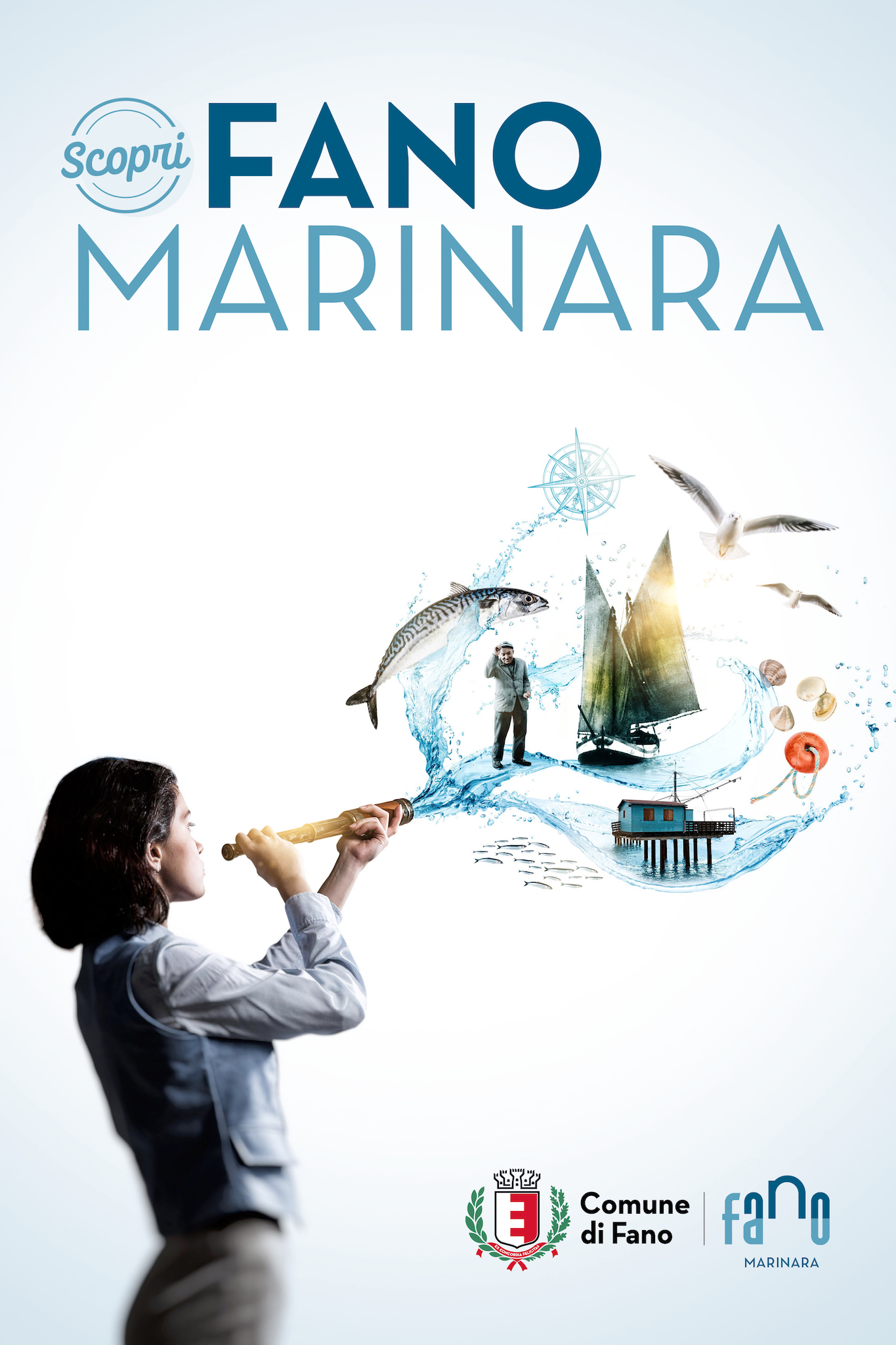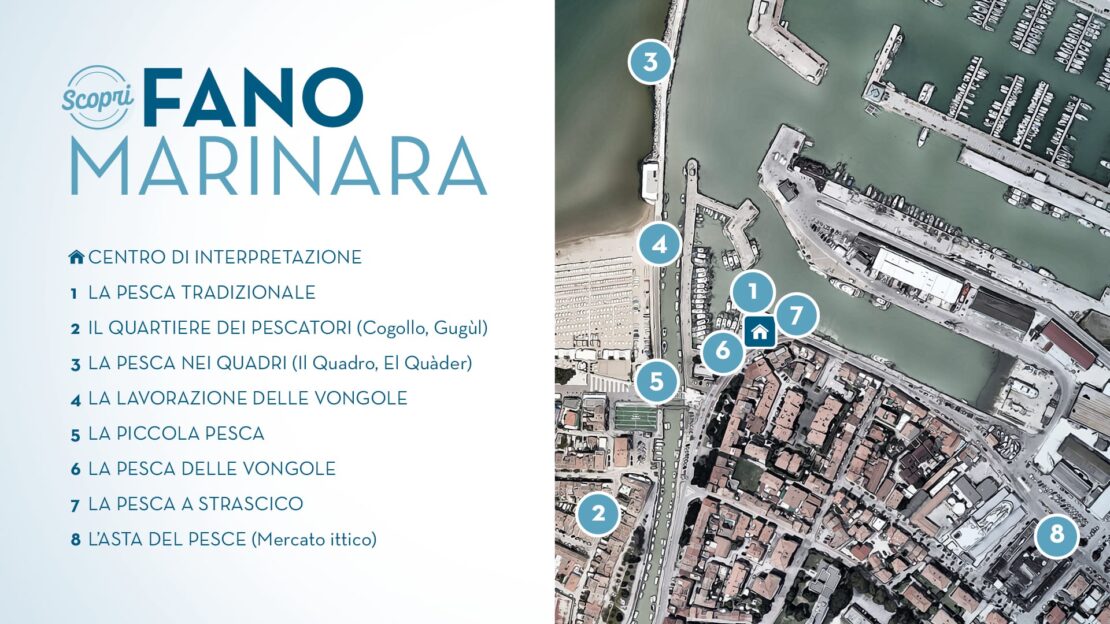Fano, seafaring city
A TOUR TO DISCOVER THE SEA AND LOCAL FISHERIES
Fano a seafaring city for generations.

Discover Fano Marinara
The port of Fano is a place that holds the city’s history and, as it evolves over time, bears witness to its cultural, commercial, social and economic changes.
Fano Marinara, an initiative promoted by the Municipality of Fano, includes the organization of guided tours to discover the seafaring and fishing world typical of this locality.
Strolling along the banks and docks of the harbor, it is possible to immerse oneself in the atmosphere of the maritime life of fishermen to learn about their history and daily activities. On the route, eight information totems fixed at points of interest provide access to text and video content.

TRADITIONAL FISHING
The essence and history of Fano are inextricably linked to the development of the port area.
The port, built in 1616, begins with the Darsena Borghese, the oldest canal and main connection to the sea, which owes its name to the man who ordered its execution: Pope Paul V Borghese.
Over time, the other docks built to serve port activities were built. The port area was then adapted to economic needs.
Iron-and later fiberglass boatyards replaced the old shipyards, which were later moved inland due to space requirements. Today, the port area also includes the Lysippus promenade and the paintings, which are among the most characteristic places along the waterfront.
The harbor is framed by the colorful fishermen’s houses, central to both the working activities and social composition of the city.
THE QUARTER OF FISHERS (Cogollo, Gugùl)
Can an object name a place? If that object and place are linked by the same deep tradition, yes. This is the case with the Gugùl. The cogollo, or gugùl in Fanese dialect, is a net that was used to catch eels.
Once laid on the bottom, its conical shape with internal constrictions allows fish to enter but not exit. In Fano, the Gugùl is one of the first concentrations of houses for the harbor dwellers and the place where, even today, the fishermen’s children live.
Its name comes from the fact that it is a small road closed at the bottom, just like the cogollo. The terraced houses of Gugùl are a riot of color.
On each of them you will find a tile reproducing the sail of a boat.
On the sail, the symbol identifying the “lineage” of the fisherman living there.
THE FISHING IN THE FRAMEWORKS The Painting (El Quàder).
Fano paintings, reminiscent of the trabucchi on the Abruzzi and Apulian coasts, are the wooden cottages built along the piers since the early 1900s.
Called “scales” or “lugèrne” depending on the area, in Fano they are known as “quadri.” A word that comes from the Fanese dialect “quader” and indicates the square iron perimeter on which the fishing net was fixed.
The frameworks, resting on poles planted deep in the sand, were simple and functional, and allowed fishing even when the sea was too rough to go out in a boat.
The modernization process in the early 2000s brought them up to safety standards and made it possible to continue using them. But while picture fishing was also once intended for sale, today it is purely amateur.
CLAM PROCESSING
The port area of Fano hosts a number of companies that process the catch to prepare it for sale.
In particular, New Copromo, which specializes in the different stages of clam processing.
Clams arrive here every day and are then transported to the inspection facility and screened for size and condition. Species other than purassa or venus gallina are excluded. Then division and packaging is done according to size, a factor that will determine the price.
Control includes verification of shellfish provenance and microbiological analysis necessary to ensure the safety of the final product. In the plant, automatic machines purify the clams and maintain their optimal temperature.
THE SMALL FISH (Small Fishing Dock)
Fishing is an incredible activity because it is evolving with technology while maintaining the ancient charm of knowledge passed down from generation to generation. The rules and techniques are different and special that for each species, and knowledge of the different realities is critical to the success of this activity.
This is the dock for small-scale fishing. The harbormaster’s boats and those engaged in various fishing activities are moored here. The variety of techniques allows fishing to be adapted to the characteristics of the catch.
Of particular interest is that of surface longliners catching tuna and swordfish. A Japanese technique involving the use of a long nylon thread on which numerous hooks are hooked.
The dock also berths a catamaran for processing mussels that he grows in a nursery located two miles from the coast.
THE CLAM FISHING (Clam Dock).
In the Marche region, clam fishing was practiced manually as early as 2,000 years ago.
Technological development has since revolutionized this activity.
The Marche region has the highest number of clammers. In Fano they can be found here in the clam dock in the harbor, and they only fish for wild clams.
These vessels are the result of a long technological evolution and increased environmental awareness. Thanks to technology, it is possible to select the catch in order not to disturb the marine balance.
This type of fishing is identifiable with the area, and Fano is a hub of it for both fishing and trade. There are strict national and European rules regarding both vessel and catch characteristics. The fishermen are united in a compartmentalized consortium that manages the business.
Here purasse or venus gallina are the stars of a wide variety of fish dishes.
TRAWLING FISHING (Darsena strascico)
From the clam dock to the open sea and back. The trawlers leave every morning to trawl off the coast between Ancona and Rimini and return in the night to land their catch to sell at the wholesale fish market (leg 9). When fishing, the nets are hauled to the bottom, and their opening is achieved with the two large iron otter boards visible on the side of the stern. On weekends, fishermen rest and boats are moored in the dock waiting for Monday.
In the early 2000s, there were more than 65 trawlers docked at the Fano pier operating off the Croatian coast.
Today, regulations are stricter and more careful about environmental implications, the number of fishing boats has decreased to about 10, and they fish in different areas, where they find a greater variety of species depending on the distance from the coast, the seabed and the period of activity.
THE FISH AUCTION (Fish Market)
From sea to table, the journey of the catch always passes through the fish market, where every day fishermen bring the fruits of their labor destined for the businesses that compete to buy them. Why talk about competition? Because a special fish auction takes place at the fish market.
Here it is the buyers who set the price. First, the quality of the products is checked, and a draw defines the sales order.
Then “the reverse auction” begins! The value of the fish begins to drop and stops only when one of the participants locks in the price by pressing a button, winning the box.
The buying and selling is rapid. The catch must be astated in a short time so that buyers can take it to their businesses in the best fresh condition. When the auction is over, the empty boxes are retrieved and the fish market washed.
All set for the next day.
Info and reservations
Call Call&Go at
+39 366 3426985
or fill out the form below and request information.
We will get back to you as soon as possible!